THE
FOUNDING OF ADDIS ABABA FOOD NOT BOMBS IN
ETHIOPIA
After a short two hour flight on one of Ethiopia
airlines new jets we arrived in Addis Ababa. As I was going through
customs to get our visa I told the officer that I was attending a
conference hosted by the Ethiopia Vegan Association. That surprised the
man behind me in line who remarked he was pleased to know their was such
a movement. I told him I volunteered with Food Not Bombs and that
farther interested him. I got my visa, picked up my bag at the carrousel
and sure enough my hosts were there to pick me up. They were all smiles
and so welcoming. The drive to the Ras Hotel was quick. My bank card
didn't work but fortunately I had $25 U.S. and they took that for the
evening. The room was on the Nelson Mandela floor and a photo of a jail
cell with the words Nelson Mandela's cell for 27 years hung outside my
room 210. The room was fantastic. New washroom fixtures and two
comfortable single beds. A complex shower and a TV with four channels
one of which was tuned to the BBC news. After being so careful with the
water in Nairobi the hot shower seemed like a blessing.
 Keith
talks about Food Not Bombs |  Climate Change and
Sustainable Development Conference | 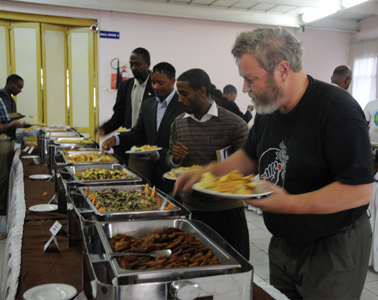 Vegan lunch at the
conference |
The next day I had the wonderful Ethiopian breakfast and sat on
the cafe porch for a few minutes when Dr. Anteneh arrived in a little
blue taxi. We sped off to the Global Hotel for the conference. Ballroom
A was huge and had tables, chairs set across the far end. The guys from
the Ethiopian Vegan Association greeted us. I place my flyers on one of
the registration tables and soon cases of fresh water in bottles arrived
followed by a steady flow of participants. Each person filled out the
registration form then carefully collected one copy of every flyer I had
set out on the table. By the time all 60 or so participants had arrived
every flyer was taken. This proved to be very good as it took some time
before all the technical issues of the projector and computer were
worked out but soon the conference was under way. The December 9th
conference "Acting on Effective Solutions to Climate Change and
Sustainable Development" was organized by the Ethiopian Vegan
Association (EVA) in association with International Fund for Africa
(IFA) and Save Mothers and Children of Oromia (SMCO).
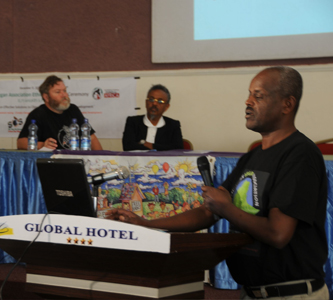 Keith, Doctor Anteneh and Worku Mulleta |  Attending the Climate
Change Conference |  Conference
participants listen to speakers |
After Doctor
Anteneh opened the conference Worku Mulleta gave a powerful
presentation called "Veganism & Climate Change" Worku explained some
shocking facts. Half of the worlds harvest is fed to livestock. The
grain fed to animals could feed 2 billion people. He reported that the
World Watch Institute claims that It takes 6.9 pounds of grain, 44
gallons of gasoline and 430 gallons of water to produce 1 pound of pork.
It takes 4.8 pounds of grain, 25 gallons of gasoline and 390 gallons of
water to produce 1 pound of beef while a pound of Apples take 49
gallons; Carrots 33; Potatoes 24; and Tomatoes use 23 gallons per pound.
He also pointed out that the United Nations reports that meat production
is responsible for 30 percent of climate change from deforestation of
rainforest to produce grazing land to the methane produced through
factory meat production and use of fuel for transportation and
cultivation needed for meat production. Dr. Anteneh highlighted many of
the same details but made the point that while the people of Africa were
not responsible for causing climate change through their eating of meat
if trends continued they may add to the crisis while at the same time
the people of Africa face greater impact because of the droughts, floods
and other effects caused by the destruction of the climate.
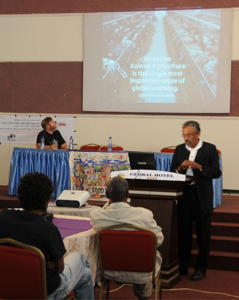 Powerpoint on climate change | 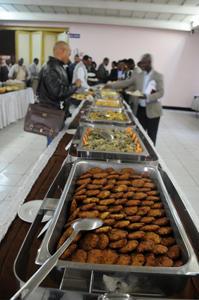 Vegan food for all | 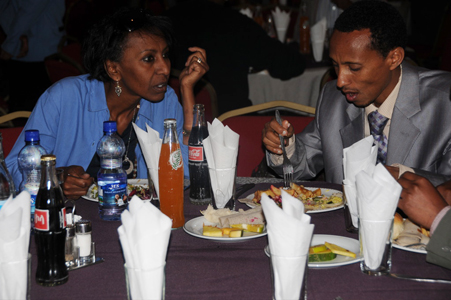 Lunch at the conference |
The participants included many interesting people, several that
worked for the Ethiopian government's department of Agriculture, an
organic gardener and people seeking to end hunger by dehydrating
potatoes. Once we broke for lunch I had time to meet and speak to many
of these informative people. Once lunch ended the activists with the
Ethiopian Vegan Association filled baggies with the left overs. They
packed parts of each dish in nearly 100 bags.
 Putting the meal in bags |  Injera made from teff | 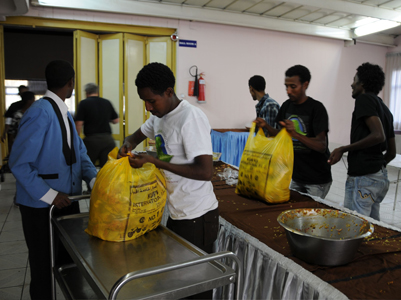 Packing the leftovers |
Each bag included injera
made of teff which is used instead of silverware. Teff is unique to
Ethiopia and is one of the oldest and smallest cultivated grains. It is
like a thin crepe. The other foods are placed in little piles on a sheet
of Injera and little rolls are used to scoop up the lentils and other
preparations. Injera task two or three days to make. The Teff is ground
fine and mixed in water with yeast and a tiny amount of flower petals.
THis is left to sit for two days until it ferments and starts to get air
bubbles. The batter is cooked on a griddle called a Mitad. Once cooked
it is a brown grey with tiny holes on one side and smooth on the other.
We placed several rolls in every bag so that our vegan meal could be
enjoyed it a typical Ethiopian manner. The hotel workers were very
pleased and helped us take the food to he basement garage where we
waited for a van. The volunteers negotiated a private fare and after
explaining to the general public that we had secured the vehicle for
ourselves we headed out to find the hungry.
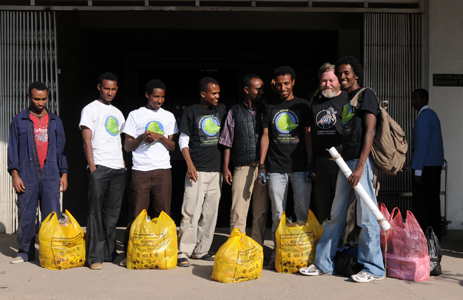 Food Not Bombs ready to take the van |  The Canon |  The first to eat |
It wasn't long before we came to our first location where we out our
plastic bags of vegan Ethiopian food to the hungry at Theodros Square on
Churchill Avenue about three blocks from where I was staying at the Ras
Hotel. We found many homeless people in the vacant land around the
square. A huge replica of the giant cannon used in the war against the
British sat in the center of the square. After feeding a dozen very
hungry people we took the van up to the Piassa area outside St. George's
Ethiopian Orthodox Cathedral A line of over fifty people was organized
along the outer wall of the church grounds. The church was built in 1896
in honor of St. George, whose relic was carried at the Battle of Adwa
where Ethiopia defeated the Italians marking Africa's first military
victory against a European army.
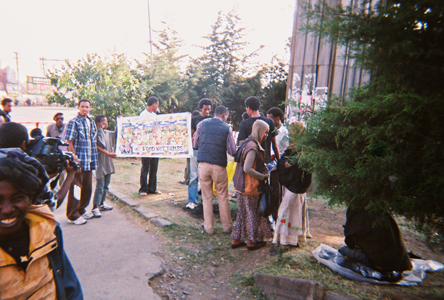 Sharing food near the Canon |  Homeless and his puppy eat | 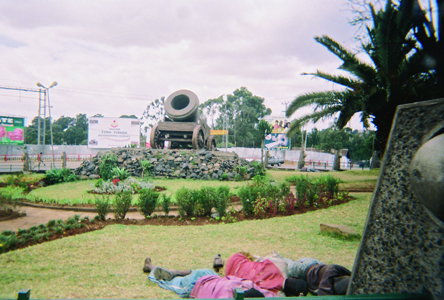 Homeless sleep by monument |
We started to hand out the vegan
meals as soon as Mesfin arrived with their special banner announcing
that that Ethiopian Vegan Association, the International Fund For africa
and Food Not Bombs International were supporting the action. A local
homeless man helped organize the people so that the blind and children
were served first. The people were gentle even though they all reached
out for the food eager to have something to eat.
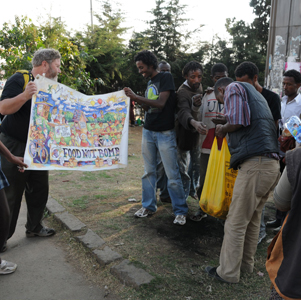 We share more food near the Canon | 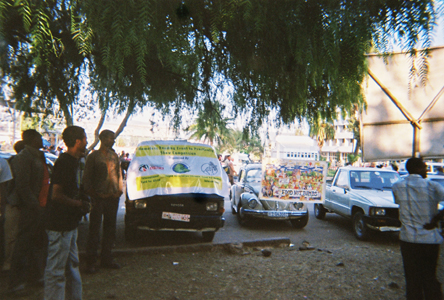 We move to the church | 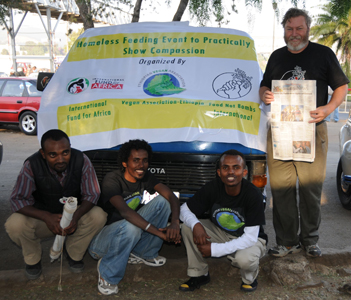 We hang our banners |
Just as we were about to share the last of our food a couple of local men started to ask us
why we were taking photos. They became quite upset and soon a crowd was
busy discussing the issue. Several children pinched the the skin on my
arm to see if my white color would come off. One little boy was very
kind to me and held my hand.
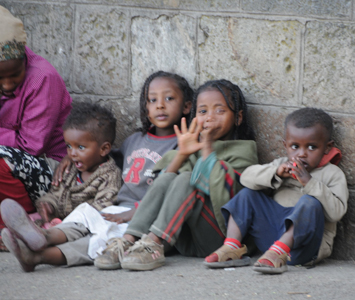 The children wait | 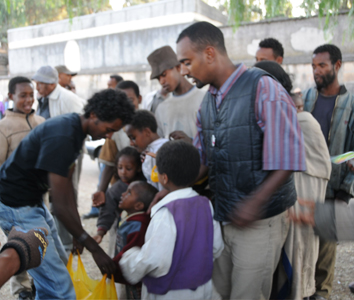 Sharing outside the church | 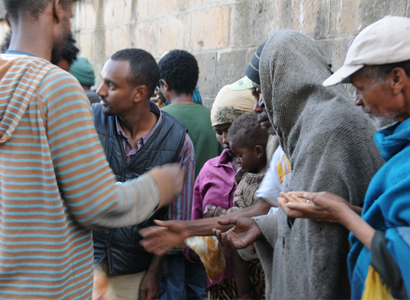 Reaching for the vegan meal |
As the other volunteers talked with the men
that wanted us to explain ourselves a drunk man would try to grab the
little boy who would have a look of horror each time he was approached.
I had to pry the boy away from the drunk man several times. At one point
the drunk man reached inside my pants pocket to take something but I
took his hand way and he was not able to take anything from me. After
nearly an hour of talking with the men that felt we had committed a
crime by taking photos we agreed to go to the police station with them.
 Sharing with the blind | 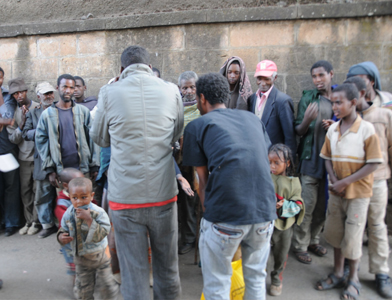 Sharing outside the church | 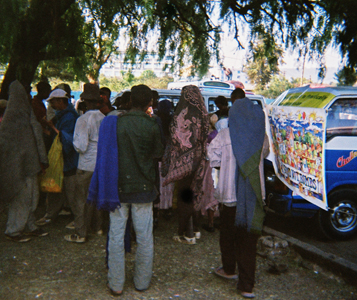 Police question us |
The station was down a very rough street behind the mercato or market
area. We waited our turn and soon we found ourselves talking to the
local captain of the Addis Ababa Police. He was a gentle man and saw we
were just interested in feeding the hungry. He told the men that brought
us in to apologize and soon we were all hugging one another. The
activists gave the guys who turned us in Vegan Association pens and
wished them well. We returned to the area near the church and everyone
caught their van rides home.
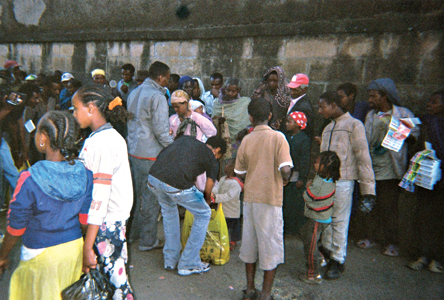 The children wait |  Sharing outside the church | 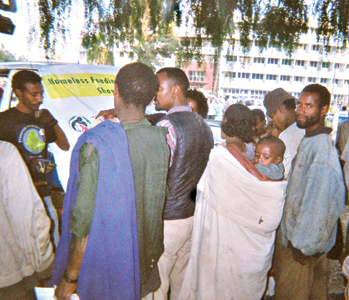 The polce stop us |
Mesfin then took me to see the mercato. We passed the plumbing area,
shoes shops, rugs and cloth and then the narrow allies of spices. We
stopped off at the produce market with colorful bags of tomatoes,
potatoes, carrots, eggplant and all variety of beans. He introduced me
to the venders with huge bags of colorful spices. I tasted the brilliant
red powder and it was such a rich taste I had to know more. We sampled
another vender and realized the spice known as Berbere had many tastes.
Mesfin bought me a bag of Berbere and then introduced me to toasted
grains and bought me a bag. On the way to visit the Khat venders he
bought me a bunch of fresh Chickpea plants pulled from the ground just a
day or so before. The fresh Chickpeas tasted sweet. We soon found the
Khat venders. Mesfin told me that if we had come in the morning the
entire plaza would have been staked in Khat. There were still small
piles around the yard and the rooms surrounding the plaza were lively
with dozens of men and women with glazed eyes balancing on makeshift
benches chewing away on spindly green leaves. Mesfin explained that
there were many kinds of Khat each that created a different speedy
feeling. The short stemmed Chirra, the powerful Umerkule, red leafed
Kuda, fresh Karabule and Abba Chebsi named for an important Khat dealer. Mesfin was doing more then just organizing Food Not Bombs he also owned a mushroom commpany and saw that as a way he could provide vena food in a limited space.
Later that evening we went to see a Jazz concert and then back to the
Hotel Ras.
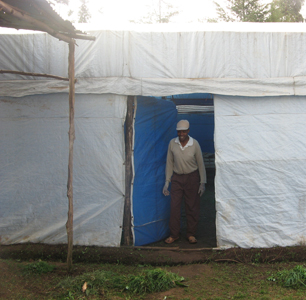 MeRo Mushroom Farm House | 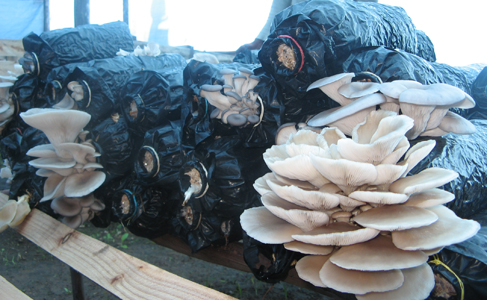 Oyster mushrooms |  Harvesting the Oyster mushrooms |
The next morning I sat on the patio drew a picture of the Ras hotel and spoke with
a number of local people including a young student named Mekonnen
Tilahun. He told me about his problems with college and studies in
accounting. I also bought a copy of The Land of The Yellow Bull, a novel by Ethiopian author Fikeremarkos Desta from a street vender that had been walking outside the hotel holding a stack of 30 mostly used books.
A tiny man that couldn't stand shuffled on his bottom past the hotel smiling at everyone. The traffic control officer, a pleasant young woman broght him tea which he drank sitting on the sidewalk. I included him, his rasta knit cap and bright smile in my picture.
As soon as Mekonnen departed Mesfin arrived. We reviewed the
steps to starting a Food Not Bombs and before long Dr. Anteneh arrived
and off to enjoy a traditional Ethiopian meal at the home of one of his
friends. That afternoon we met at the "Executive Lounge" on the top
floor of the Addis Ababa Hilton and talked more about how The
International Fund For Africa, the Ethiopian Vegan Association and Food
Not Bombs could work together.
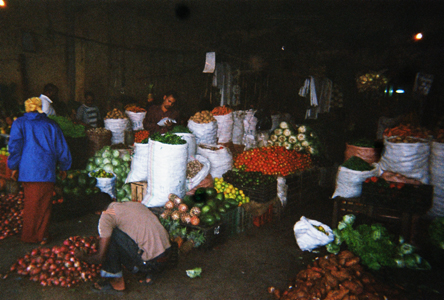 Produce market | 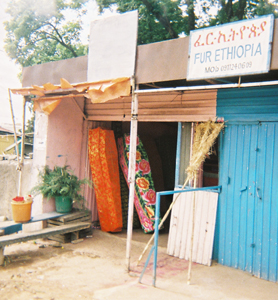 Caskets for sale | 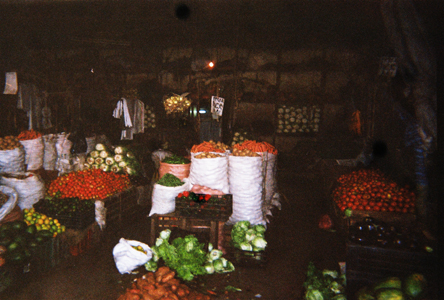 Fruit and vegetables |
The next day I set out to draw a picture of the lion monument a block
from my hotel in Unity Square. The Lion of Judah Monument was designed
by French sculptor, Morris Calka and constructed in 1955. The monument
sits outside the National Theater to honor the Silver Jubilee of Emperor
Haile Selassie. An earlier Lion of Judah Monument stands outside the
main train station. I had a lot of help in finding a place to sit along
Churchill Avenue. People tried to direct me around the plaza and when I
finally found a view I liked others found card board for me to sit on.
At first the people that helped me set up were the only ones interested
in my activity but as the drawing took shape they started to direct
people over to see what I was doing. At one point a white couple passed
by and my supporters were sure they would be interested but they swiftly
walked by ignoring the enthusiastic suggestions. Soon a crowd was around
me watching every line. As I was about to finish a child saw that I had
other drawings in my sketchbook and lifted the page. The crowd
encouraged me to show them all my drawings so I turned the book to the
audience and slowly turned each page. As each drawing appeared my
audience would whisper compliments. "Very good, very good" remarked one
of the children. An older man told me his son was an artist and would be
having a show at the end of the month. When I came to the final picture,
the drawing I had just worked on the crowed clapped and cheered with
excitement as though they had just watched a movie or concert.
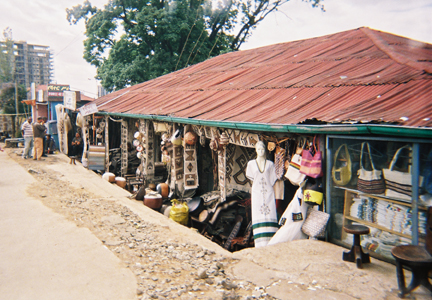 Gift shops in Addis Ababa | 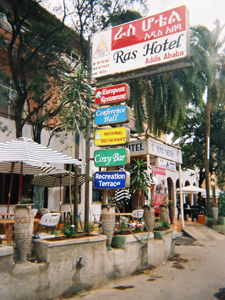 Hotel Ras |  Lion of Judah Monument with the National Theater |
That evening Dr. Anteneh took me
out to see The venue was crowded with over a hundred people. The meal
was beautiful laid out on injera made of teff. The dancers showed
examples of Guragigna, Wollo, Tigrigna dance. The next day was filled
with meetings. Mesfin and I first visited Flker Leselam Development
Organization. I asked the young general manager Mekbibo Zerihun how he
started. Mekbibo explained how he had been working with an NGO in a
village outside of Addis Ababa. Each evening he would return to his
hotel and on the way would see very poor children in need of food. He
asked the hotel to make food for six of the children and told the staff
he would pay for their meals. The hotel owner was touched and agreed to
split the cost with Mekbibo. When he returned to the city he talked
with some of his friends and they decided to see if they could help the
orphans of parents that died from HIV aids and at the same time they met
with people from South Korea that were wishing to help the people of
Ethiopia. They agreed to start the Flker Leselam Development
Organization and the Korean returned home to raise money. They organized
a system where Koreans could sponsor a child in Addis Ababa for about 25
cents a day. The child would arrive before school to eat a healthy
breakfast then they would walk to class. Each child was helped with
locating a local family or relatives to live with. Special events would
be organized to raise money for the child's uniform and supplies. Flker
Leselam organized events like an essay contest where the students were
asked to write about their life. The "winners" were given prizes donated
by the Koreans and presented by local celebrities. The sponsors were
provided with the child's grades and each day the volunteers filled out
a form about the number of children fed and meals shared. The form even
included the names of all the volunteers, weather, exact time the meal
started and notes about any problems. I was very impressed by their
structure and asked Mekbibo if he could provide me with a copy of this
form which he did. They have been feeding nearly 500 children a day for
several years. The also took the children out to the country once a year
and they were staring classes in computers which started with the basics
of how to use one of their three computers as well as how to repair
them. It was inspiring to visit with the people at Flker Leselam.
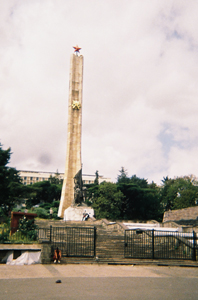 Monument from Socialist Era | 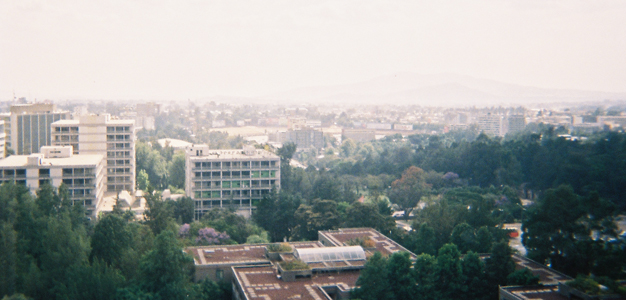 View of Addis Ababa from the Hilton | 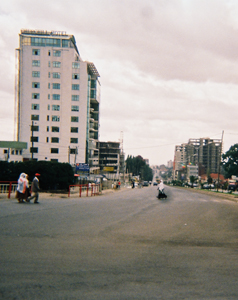 Churchill avenue in Addis Ababa |
Mesfin
and I then went to visit Sisay Kiffe. Sisay volunteered with the Society
of Animal Welfare and provided us with their newsletter. The SAW was
working with Dr. Anteneh and other Ethiopian activists to draft and pass
nationwide animal welfare laws. There is a hug problem with the poor
treatment of stray dogs and dogs that are chained and used for security.
Another problem is the treatment of horses and donkeys that are worked
very hard and abandoned once they can no longer carry their loads or
pull there owners plows. They are abandoned on the edge of town as
protection from hyenas and lions that attack and eat the weaken horses
and donkeys instead of entering the villages to feast on the chickens
and other livestock still valued by the farmers. The government has
donated land for a horse sanctuary and is considering new legislation.
Sisay is also working on a project called Mena Mahiber Potato
Dehydrating Project and has been given land by the government to build a
pilot program. Sisay explained that one important way that Ethiopia can
protect its people from future famines was to dry potatoes for times
when the harvests were poor. He was working with the local Rotary Clubs
in Ethiopia to raise funds for the project. I agreed to speak with
members of the Rotary in the United States to see if they could help.
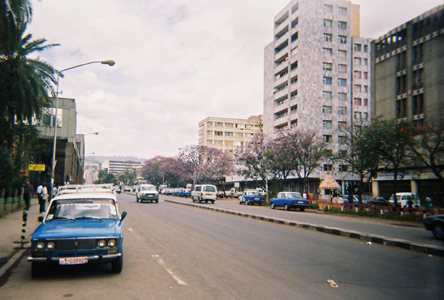 Churchill Avenue outside the Hotel Ras | 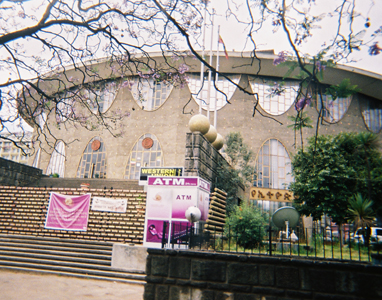 The National Bank of Ethiopia | 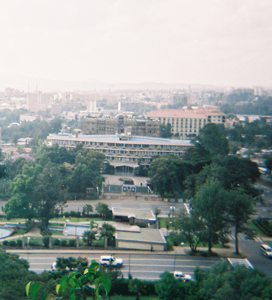 Addis Ababa from the Hiton |
After that fruitful meeting Mesfin and I took one van after another out
to the edge of Addis Ababa to see Dr. Mengistu Woube's Biodifood organic
garden in land donated by the city. Dr. Woube organized the cultivation
of an acre of land near the city dump. He raised money to pay for his
volunteers to travel to the garden and help with the planting, weeding
and harvesting of vegetables and fruit trees. The garden had lines of
long raised beds with paths on each end and one down the center. A huge
plastic water tank sat in the middle and a shed sat at the east end of
the field. They stored their tools and raised mushrooms in the shed. A
family lived in one end and guarded the garden. The volunteers were
rewarded with what harvest their families required and the rest was sold
to local people living near the garden. They were seeking additional
funding as their first grant had been spent. Onions, leeks, Collards,
carrots and many other vegetables were thriving. The garden was
impressive and they hoped Food Not Bombs would be interested in
participating. Mesfin was such a wonderful host. That last day we walked
around the city and I took the last of my photos. He had then developed
and made a digital file for me. We enjoyed a vegan dinner at the Hotel
Ras and he traveled with me out to the airport. It was clear the Mesfin
and the rest of the activist with the Ethiopian Vegan Association will
be successful in their work with Food Not Bombs. They are already
planning to share food again on January 6th, the Ethiopian Orthodox day
of Christmas.
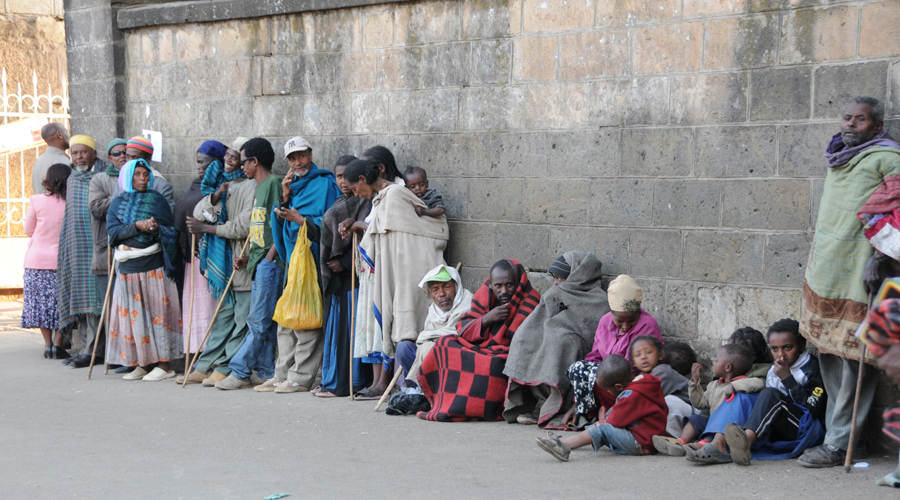 The people of Ethiopia have survived famine but Food Not Bombs is working to make sure that never happens again.
You are
invited to join Food Not Bombs in our work to make Africa's future
bright.
 Addis
Food Not Bombs - Ethiopia
Addis
Food Not Bombs - Ethiopia
Ethiopia Vegan Association
P.O. Box
28305
Addis Ababa, Ethiopia
0923933449
meshagem (at) gmail.com
www.facebook.com/FoodNotBombsAddis
|
|
THE GOOD ETHIOPIAN |
Ethiopian Vegan Association |
Ethiopian Vegan Association | International Fund for Africa |
| A Well Fed World | Biodifood Association |
| Ethiopia country profile |
| Contacts in Africa |
| Start a Food
Not Bombs | Main
Menu | Contacts |
Help Africa! Donate A Dollar For
Peace |
|

















































